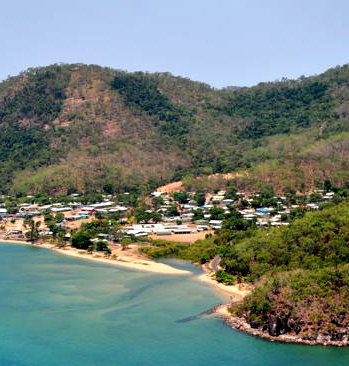Tough times getting desperate on dry island
 Thousands of people have been forced to bathe in and drink contaminated water, as a tropical island off Queensland becomes considerably less idyllic.
Thousands of people have been forced to bathe in and drink contaminated water, as a tropical island off Queensland becomes considerably less idyllic.
Palm Island sits just near the Great Barrier Reef, and it is about to run out of water as local dams dry up.
Vulnerable residents like children and the elderly, have suffered from nausea, diarrhoea and outbreaks of boils, as the water on Palm Island turns a “filthy, murky dark brown”, reports say.
About 4000 people live on Palm Island, situated about 65km northwest of the coast near Townsville.
Palm is the main island of the Greater Palm group, consisting of bays, beautiful beaches and steep forest mountain peaks.
But the normally postcard-perfect island is in the grip of a severe drought that is pushing the region’s only two dams, Francis Creek and Solomon, to dangerous lows.
Some expect them to deplete completely by Christmas this year.
Palm Island mayor Alf Lacey has told News Corp reporters that the dams will only last the community another 94 and 81 days respectively if the rain stays away.
Mr Lacey said the situation was complicated further by the fact that water meters were not installed in the community’s dams.
“We are using just over 1.4 mega litres of water for town usage per day,” Mr Lacey said.
“It’s concerning for us here on the island but I don’t want to be the one who presses the panic button.
“Our issue at the moment is asking residents in town to play their part in conserving water in their households on the island.”
Changes have been made so that essential services only are allowed on the island.
It means visitors, including “church groups, government and non-government agencies”, were restricted access in a bid to conserve water,” Cr Lacey said.
“You don’t come to Palm Island unless necessary,” he said.
Thirty-eight-year-old Palm Island resident Lyndell Prior told reporters her family of five young children were forced to bathe in the “dirty, brown” contaminated water for the last two weeks.
Ms Prior told News Corp her children had “sore tummies, diarrhoea” and were “feeling nauseous in stomach”.
“A doctor made the comment that it was the water and said ‘you’d be surprised how many people are coming through the Palm Island hospital with the same symptoms’.”
Palm Island’s hospital, the Joyce Palmer Health Service, “has not reported any increase in presentations of children with the illnesses described [by Ms Prior]”, according to Townsville Hospital and Health Service chief executive Julia Squire.
Palm Island Council chief executive Ross Norman has told reporters that the discolouration of the tap water came from aerators, which “turn the sediment over” to oxygenate it and prevent stagnation when water levels are extremely low.
“We’re looking at getting some independent people to come and look at the water, and do an assessment on how much water they think is in the dams,” he said.
“The water is already dirty but all we need to be able to say is that the water is fit for human consumption.”
Mr Lacey said he told the state’ Local Government department about the water shortage, and is now waiting on the Local Disaster Management Group to co-ordinate an emergency response - if a crisis is declared.
“In terms of where we go from here, it would be a matter for the local disaster management team to kick into play and recommend,” Mr Lacey said.
“It’s the best bet at this point of time to just pray for more rain.”
With Australia falling into the grips of an El Niño weather event – which brings long periods of extremely dry weather - the drought on Palm Island is unlikely to end soon.








 Print
Print